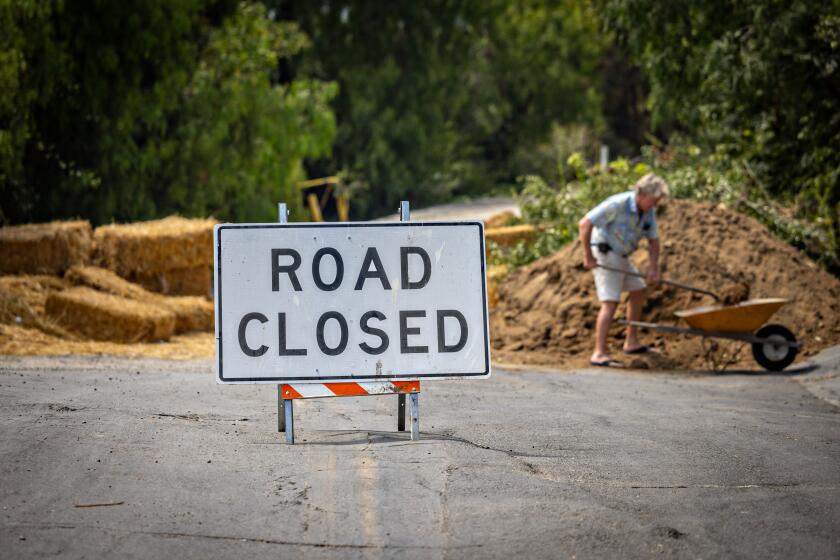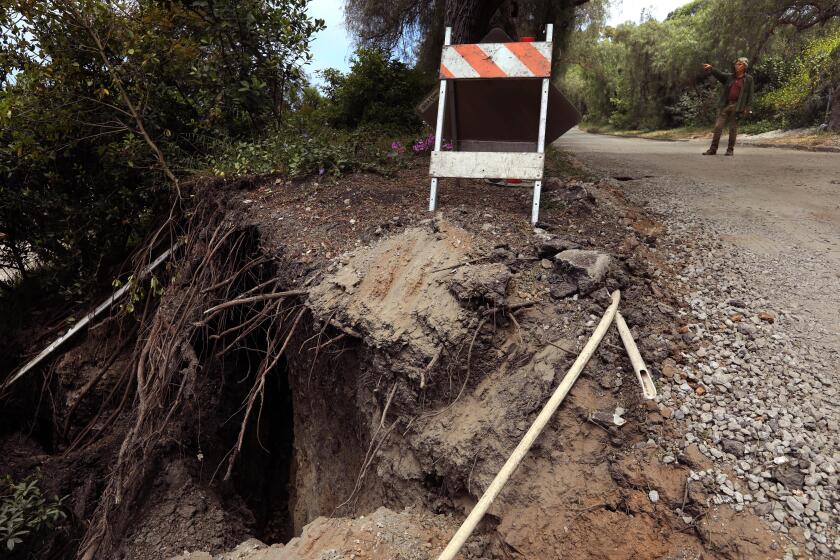Powerful new rainstorm brings risk of debris flows to L.A. fire zones this week

- Share via
Southern California faces a risk of damaging debris flows this week, as a potentially strong atmospheric river is set to arrive in the region.
Rain is likely to arrive by Wednesday morning, but the bigger threat is expected early Thursday, and continuing through Thursday night or Friday morning. The storm threatens to drop significant amounts of rain, forecasters say — possibly 2 to 4 inches or more along the coast and in valleys, and 4 to 8 inches or more in the mountains and foothills.
There’s a 60% chance of rainfall of that magnitude in Santa Barbara and San Luis Obispo counties, and a 40% chance in Los Angeles and Ventura counties, the National Weather Service said Sunday. The risk of significant rainfall in L.A. and Ventura counties worsened from Saturday’s forecast, which described a 30% chance of high rainfall.
While rain of that magnitude would do wonders to end what’s been an especially devastating winter fire season, it also threatens to trigger another disaster that’s all too familiar for many Californians.
Here’s what you need to know about landslides:
After a relatively weak storm expected to arrive in L.A. late Thursday, forecasters say a potentially more powerful storm could hit around Valentine’s Day.
Why is California at risk?
Landslides have always been a threat to those living close to the mountains. All it can take is an intense amount of rain in a short amount of time to create deadly and damaging flows of mud and debris.
California’s mountains present a particular challenge, as they’re quite tall and the elevation drops rapidly as water drains to the sea. The situation has become more dangerous as residents increasingly developed and inhabited these paths of destruction.
The online tool can point wildfire survivors to resources they may be eligible to receive.
How do wildfires worsen the landslide risk?
When hills are verdant and healthy, vegetation can anchor the soil in place, even during heavy storms. But when that protective blanket is burned off, hillsides become vulnerable to erosion, and slopes can come crashing down in a torrent of mud, rocks and dead branches like whitewater rapids, imperiling any homes — or anyone — in their path.
The heat from a fire also makes it harder for water to infiltrate the top soil layer, U.S. Geological Survey hydrologist Jason Kean said in a previous interview.
Ash tends to clog the soil, and oily substances can hamper the ground’s ability to absorb water. Impact from the rain can also help seal the top layer of sediment.
As a result, the soils become repellent to water. Instead of percolating below the surface, water starts flowing downhill — picking up rocks and debris in its wake, Kean said.
It’s like water on a parking lot or the surface of a playground slide, he said: “When the rainfall hits it, it just runs right off. … The rapid runoff from these bare hill slopes can quickly pick up sediment, and that can transform into a really nasty debris flow.”
Authorities in L.A. County say the recent uptick in arson arrests was probably the result of increased public attention to common smaller fires, not the work of copycats.
What are the different types of landslides?
“Landslide” is an all-encompassing term that can describe any movement of rock, dirt or debris downhill.
But there are a few distinct varieties, as defined by hydrologists:
Mudflow: Water rushing down with only mud. This is considered a type of shallow landslide — less than 15 feet deep.
Debris flow: When water rapidly flows downhill and picks up rocks, branches, sometimes even massive boulders and cars. This is also considered a type of shallow landslide.
Hydrologists don’t typically use the term “mudslide,” but it’s widely used and understood by non-scientists. The word is a portmanteau of mudflow and landslide, and is commonly used to describe debris flows or mudflows.

How a debris flow works
How fast does rain have to fall to trigger a debris flow?
Rainfall rates of half an inch per hour is the typical starting point for when debris flow can be triggered in recently burned areas.
The higher the rainfall rate above that threshold, “that’s where we could get some more appreciable and significant debris flows,” said Ryan Kittell, a meteorologist with the National Weather Service in Oxnard.
Can landslides happen after the rain stops?
Yes. A shallow landslide involves a saturated hillside that collapses but does not move very far — maybe burying a neighboring roadway with dirt and rocks. They can happen up to an hour after a burst of intense rain.
Debris flow can also occur even if there isn’t a history of recent wildfire.
How damaging or deadly can debris flows be?
About a year ago, pounding rainfall triggered damaging debris and mudflows in a number of hillside neighborhoods in Southern California, including Beverly Glen, Studio City, Tarzana, Baldwin Hills and Hacienda Heights.
Some of the state’s deadliest debris flows have struck after wildfires.
When the Thomas fire swept down from the Los Padres National Forest and took aim at this coastal town in December, the looming disaster was impossible to miss.
In January 2018, 23 people died and numerous structures were destroyed when a river of mud and rock flowed through Montecito, which had been burned less than a month earlier in the Thomas fire. That fire, one of California’s most destructive on record, burned 282,000 acres in Ventura and Santa Barbara counties and destroyed more than 1,000 structures.
In 1982, a debris flow hit Love Creek in the Santa Cruz Mountains. The area hadn’t burned beforehand, but heavy rains destabilized the slopes. Ten people died, including two children, and 30 homes were destroyed.
Moments into New Year’s Day 1934, a major flood and debris flow came sailing down La Crescenta Valley, triggered by heavy rains preceded by a fire in the nearby Angeles National Forest. A 20-foot wall of mud and rocks came thundering out of canyons, killing 45 people and destroying more than 400 homes, according to Los Angeles County archives.
Homes built on land with past landslide activity are on the market. Here’s how homebuyers can assess a property’s risk to land movement.
How long does it take for hillsides to recover from wildfires?
The highest risk for debris flow following a wildfire is in the first year or two afterward.
But burn areas are still more prone to debris flow for three to five years after a fire — the amount of time usually needed for vegetation to grow back. With each additional year of recovery, the risk decreases, experts say.
New drilling in Rancho Palos Verdes has revealed that devastating land movement has been caused, at least partially, by a deeper slip plane — meaning a larger area could be affected.
What’s the least predictable type of landslide?
The kind that can strike on a dry day.
In areas where the bedrock is very deep, rainwater can seep deep underground during multiple rainstorms. During a series of repeated heavy storms, water can accumulate and build up pressure, Kean said.
The pressure can destabilize an entire chunk of land, causing it to collapse downhill. The landslide can happen slowly and show warning signs such as cracking or subtle movement, allowing people time to escape. But it can also strike rapidly with no warning, even on a rainless day months after the end of winter.
This is called a deep-seated landslide, involving landslides greater than 15 feet deep. Often, deep-seated landslides strike in areas with a history of such events. The USGS has warned that such landslides can become active many months after a very wet winter.

Animated infographic shows how debris flows and deep-seated landslides happen
What’s an example of a deep-seated landslide?
One occurred on a foggy morning in June 2005 in Laguna Beach’s Bluebird Canyon after heavy rains fell over the previous December through February. No rainfall occurred during or just before the landslide. Seventeen homes were destroyed and 11 seriously damaged.
There has been a history of devastating landslides in Bluebird Canyon. The neighborhood suffered a slide in October 1978 that destroyed more than 20 homes. The California Geological Survey said the heavy rains between December 1977 and April 1978 are believed to have played a role, along with a history of landslides and erosion at the site, and weakness in the rock.
A child’s dollhouse jammed against a chain-link fence marked “No Trespassing” sits in the shadow of a mangled brick home covered in clotted dirt.
Deep-seated landslides also hit the Ventura County hamlet of La Conchita in 1995 and 2005. The second landslide occurred at the end of an intense 15-day rainy period that saw heavy precipitation throughout Southern California. It came with no warning and buried 10 people, killing them.
Times staff writers Hailey Branson-Potts, Susanne Rust, Joseph Serna and Rosanna Xia contributed to this report.
More to Read
Sign up for Essential California
The most important California stories and recommendations in your inbox every morning.
You may occasionally receive promotional content from the Los Angeles Times.


















